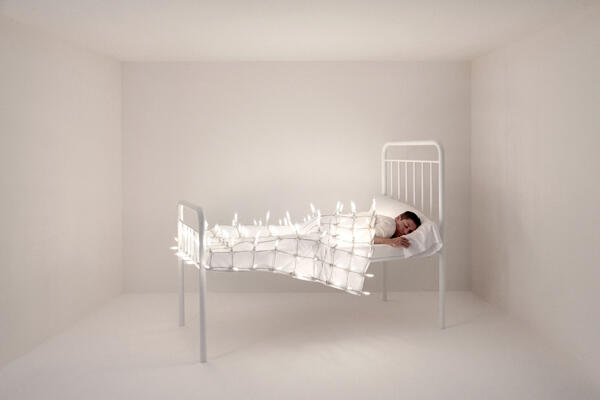Andrés Monteagudo
Ideobox Artspace, Miami
In Retroceso el sueño dormido, Andrés Monteagudo (Spain, 1970) prolongs the influence of his native city, Granada, on his childhood, through a poetics of the white cube that dissolves the boundaries between art and life.

The universes created within this cube are, in turn, spaces for escaping the world, refuges where geometry establishes an order that is safe from chaos, and places for contemplation to which viewers have free access. The artist invites them to create their own dream redoubts.
This enchanted city inhabited by ancient astronomers who stalked time from architectures built to trap its mystery in the infinite mirror of water and decipher it in the twists and turns of labyrinthine gardens, models his relationship with spaces that create a closeness between the most intimate worlds and constructed forms. The light, the bends, water itself, the invisible lines linking things in the horizon of the gaze, are present in the way in which he constructs luminous shelters inside the omnipresent white cube.
The installation Retroceso el sueño dormido hosts an inviting bed covered by a bedspread to which he has incorporated warm light bulbs. This work, which might well have been the fantasy of a child fighting against the ghosts of darkness, implies the creation of a space that is impeccable from the formal point of view and that manages to condense in a minimalist aesthetics, the urgent emotional need for an interior place, a room of one’s own which not only potentiates artistic creation but which is also, of and by itself, the most powerful metaphor for one’s own oeuvre.
In the corresponding video, it rains inside the room where he sleeps, but the persistence of the rain does not disturb the inner universe of the artist, who remains immersed in his placid fantasy world. And this is so because his poetics of the white cube − somehow an extension of the philosopher Gaston Bachelard’s poetics of space − is connected to this intermediate space, midway between wakefulness and sleep, where creative dreams live and, as the artist admits, an anthropologic rite takes place: “The encounter between the physical world and the world of imagination.” An encounter that occurs in a territory that is close to the archetypal, a particular awareness that in the border between sleep and wakefulness, as in the one between art and life, new thresholds of perception open up.
Another way of appropriating the white cube through a poetics of his own is to draw on the canvas maps composed of lines using subtle perpendicular metal elements that not only build up three-dimensionality but also a kind of cubicle. The sharpness of these lines which are perpendicular to the plane functions at the same time as a metaphor for protection. The space is open to the gaze, but it constructs a defense against vulnerability. We are faced once again with the peculiarity of the new geometry that resorts to the least referential languages, to the structure supplied by the order of the lines and dots, depositing in its aseptic expression the metaphor for the artist’s own being, a play of intercrossings in which, unlike in the vernacular geometric abstraction, affectivity and ontological content may nest. Hence that the artist invoke Bachelard: “ T he function of inhabiting constitutes the link between full and empty. A living creature fills an empty refuge, images inhabit”.
-
 (retreat-the- dormant sleep), 2012 - Installation/Instalación. Bed, fabric, electric cable, connection sockets, tubular bulbs, 63 x 85 3/64 x 49 7/32 in
(retreat-the- dormant sleep), 2012 - Installation/Instalación. Bed, fabric, electric cable, connection sockets, tubular bulbs, 63 x 85 3/64 x 49 7/32 in
Cama, tela, cable eléctrico, fichas de conexión y bombillas tubulares, 160 x 216 x 125 cm.
Credit and courtesy/Crédito y cortesía: Andrés Monteagudo




